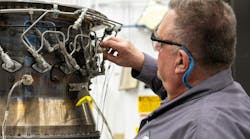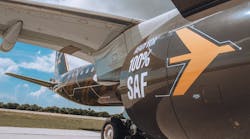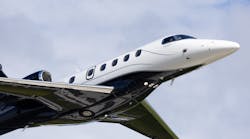Officials broke ground Friday morning at Raleigh Executive Jetport on a new multimodal charging station that will be able to power up electric airplanes in addition to cars and trucks.
The Sanford airport will be the first place in the state where electric aircraft will be able to land and recharge.
Beta Technologies, a Vermont-based aerospace company, plans to finish installing the charging cube by the first quarter of 2024. The project is the result of a public-private partnership between Beta and the N.C. Department of Transportation, which funded expansion of the adjacent apron that allows aircraft to taxi to or land near the futrue charging area. The site will also include a Level Two charging station for electric vehicles.
Blain Newton, BETA’s chief operating officer, told The News & Observer that flight is the transportation sector where decarbonization has been slowest to develop. Now, he said, the timing is right.
“It’s unconscionable to me that we wouldn’t bring this forward now that the technology and Mother Nature combined to make it commercially viable. And it’ll only get better,” Newton said.
NCDOT is primarily focused on building out the charging infrastructure for passenger vehicles, Secretary Joey Hopkins told The N&O, bolstered by an estimated $109 million the state expects to receive from the Infrastructure Investment and Jobs Act over the next five years.
A greenhouse gas inventory the N.C. Department of Environmental Quality prepared in 2022 found that in 2018, transportation was the state’s leading sector for emissions, with gas-powered cars emitting the equivalent of 41 million metric tons of carbon dioxide that year. By comparison, vehicles that don’t travel on the highway like airplanes, boats, tractors and trains combined to emit the equivalent of about 5 million metric tons of carbon dioxide.
Still, Hopkins and DOT officials are excited about electric aircraft.
“It’s all about moving towards clean energy. This is a lot cleaner than a conventional aircraft, it’s safer, it’s less cost to operate. It’s just heading us in a direction where we should have been doing this years ago,” Hopkins said.
DOT has also launched an Advance Mobility initiative, which seeks to use new and autonomous aviation technology to help deliver people and things to places where it’s not easy to access flight. A strategic plan for the initiative is set to be completed next year, but in early 2020 DOT hosted the first autonomous air taxi launch in the United States, which also featured an electric aircraft.
As they spoke Friday morning, officials stood next to one of Beta’s electric aircraft, the Alia CTOL, which featured a helicopter-like pod with a fixed wing spanning the cockpit and another wing structure fanning behind it. The wings were connected on either side by a pair of torpedo-like structures that sat atop them, and a propeller was tucked into the cockpit’s tail.
The aircraft was being flown from the company’s headquarters in Burlington, Vermont, to Duke Field at Eglin Air Force Base on the Florida panhandle. Earlier this year, Newton said, the Alia CTOL flew 336 nautical miles with another 50 on its batteries.
Newton touted the aircraft’s reduced fuel cost, noting that Beta flew much of its crew down the East Coast on a Cessna 208 Caravan that took about $700 in jet fuel. The electric plane used $17 in energy.
“The cost of electric aviation is an order of magnitude less than traditional aviation. It’s environmentally sustainable, so you open up these missions that were previously not available because of the cost of operating aircraft,” Newton said.
An early client of Beta’s, for example, was United Therapeutics, which wants to use the electric aircraft to quickly transport organ transplants. The Alia aircraft is named after the daughter of United Therapeutics founder Martine Rothblatt, who founded the company after his daughter was diagnosed with a lung condition that necessitated a transplant.
Battery packs on the electric aircraft need to be replaced every two years or so, Newton said, but that will allow customers to take advantage of the significant advances in battery technology that are taking place.
“Battery technology is improving every single year, we’re seeing it on a 10 to 15 percent trajectory. So your aircraft flies farther and carries more over time, which is kind of unheard of in aerospace,” Newton said.
Once it’s complete, the Sanford charger will be added to a network of 15 that run up and down the East Coast, with additional chargers in Texas, Arkansas and Ohio. There are 60 more in development, Newton said, with Beta hoping to have a nationwide network in place in the next couple of years. Nearly all electric aircraft will be able to use the charging infrastructure, which does not depend on proprietary technology.
The aircraft carries five separate battery packs, which sit in its belly similar to the way an electric car’s battery makes up its underside. Having about half of the total weight in its belly makes the aircraft extremely stable, Newton said.
Once it reaches Florida, the aircraft will be turned over to the U.S. Air Force’s AFWERX program, an initiative in which Air Force officials work with private sector companies in an effort to help the military stay ahead on technological advances.
AFWERX has invested $345 million in 36 electric aircraft companies over the past three years, including Beta, Darshan Divakaran, the program’s head of airspace innovation and prime partnerships, said during Friday’s event.
Divakaran added that electric aircraft can be useful to the Department of Defense because they are quieter than traditional aircraft, require less maintenance and have lower heat signatures. He outlined uses including firefighting, search and rescue, disaster relief and personnel movement.
“Let me make it loud and clear here: We are here to prevent China from poaching this emerging market from the U.S., as it did with the consumer drone market and controlling the supply chain side of things,” Divakaran said.
This story was produced with financial support from the Hartfield Foundation and 1Earth Fund, in partnership with Journalism Funding Partners, as part of an independent journalism fellowship program. The N&O maintains full editorial control of the work.
©2023 The Charlotte Observer. Visit charlotteobserver.com. Distributed by Tribune Content Agency, LLC.




